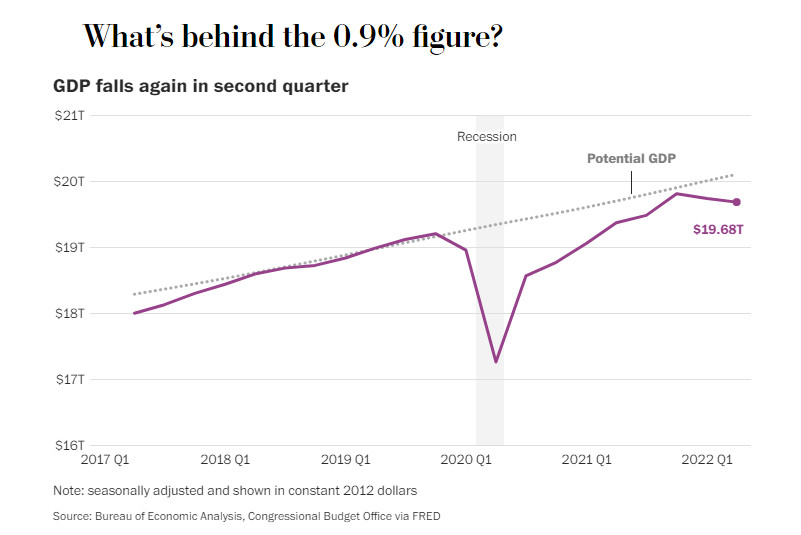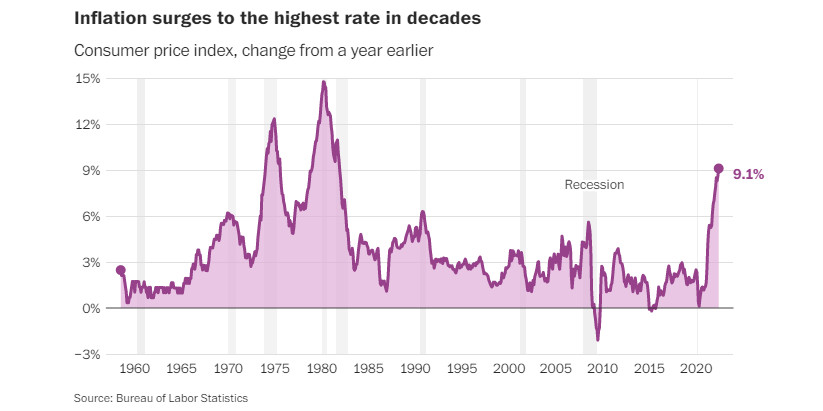
Date: 2025-10-14 Page is: DBtxt003.php txt00022819
US ECONOMY
US ECONOMIC GROWTH, 2ND QUARTER 2022
Why the U.S. economy shrank ... GDP fell at a 0.9% annualized rate between April and June 2022
US ECONOMIC GROWTH, 2ND QUARTER 2022
Why the U.S. economy shrank ... GDP fell at a 0.9% annualized rate between April and June 2022
Contributions to quarterly GDP change in Q2 2022

Lower inventories reduced GDP by 2.0 ppt. Exports grew driving up GDP by 1.9 ppt

Lower inventories reduced GDP by 2.0 ppt. Exports grew driving up GDP by 1.9 ppt
Original article: https://www.washingtonpost.com/business/2022/04/29/why-gdp-economy-shrank/
Peter Burgess COMMENTARY
I am appalled ... and indeed quite annoyed ... at the quality of the general news dialog about the state and performance of the economy. This is an incredibly important subject, and the superficial nature of the discussion is most likely going to aggravate the problems that exist by contributing to the general level of misunderstanding and the prevalence of politically motivated misinformation. It is insane to try to have a useful dialog about almost any important economic matter in a period of 30 seconds. It is rare for an anchor or moderator to have a follow on question even when one is absolutely essential for any meaningful understanding of the subject.
This issue is very much on play with a huge focus on the idea that after two quarters of slightly negative reported economic growth we must now be in a recession. Even when a commentator explains that the fact of 2 consecutive quarters of negative growth is only a starting point for identifying the economic situation to be one of recession, most moderators seem aunable to move on to any of the underlying issues that are more critical to aggregate socio-enviro-economic performance ... and God forbid, to explain how the current economic situation is linked to all sorts of changes over the past few quarters and indeed the past few years.
I would respectfully submit that we have never had a set of so many socio-economic disruptions over a period of three years as we have had in the past three years, and yet the socio-economic performance of the major economies has been managed incredibly well with much more modest damage than might normally have been expected. Clearly inflation is now an issue, but it is not anything like the cost push inflation of the 1970s that dragged on for a decade to the detriment of the United States more than any other nation. This time the inflation reflects not so much high costs (of energy) but record high profits embedded in almost everything that people consume.
Of course, this is not helped any by the messaging from the political parties in Washington. The GOP will not acknowledge anything good from the Democratic administration and the Democrats seem more intent on dividing themselves than actually getting a useful message out. This is magnified by the way the media will pick up on a negative story, but rarely does much for a 'good news' story ... the old news adage that 'if it bleeds, it leads' is still alive and well !!!!!!!
Peter Burgess
By Alyssa Fowers, Abha Bhattarai and Rachel Siegel
Published April 29, 2022 at 6:00 a.m. EDT ... Updated July 28, 2022 at 2:37 p.m. EDT
The U.S. economy shrank at an annualized rate of 0.9 percent between April and June, marking two consecutive quarters of negative growth. Six months of contraction usually signals a recession.
The contraction comes as other markers of the economy — such as the job market and consumer spending — are still showing signs of strength. That leaves policymakers, economists, businesses and families to make sense of how the economy is doing, and what the latest GDP report tells us about where we go from here.
Here are some ways to think about the economic growth data, against the backdrop of high inflation, a tight labor market and growing risks of a recession.

What’s behind the 0.9% figure?
To recap, the U.S. economy abruptly shrank at the beginning of the pandemic, then boomeranged in 2021. Last year, the economy grew by 5.7 percent, the fastest full-year clip since 1984.
Economists didn’t expect the economy to keep that same momentum this year, as federal stimulus programs wore off, and the Federal Reserve moved to raise interest rates to slow growth and get a handle on soaring prices. But many were still caught off-guard by the stark reversal in the first three months of this year, when the economy slowed by an annualized rate of 1.6 percent. Businesses were cutting back on inventory purchases after overstocking for the holidays, and imports far outpaced exports. At the time, economists widely dismissed that slump as a fluke: Consumer spending — which makes more than two-thirds of the economy — remained healthy, and there were few signs of overall deterioration.
But the economy appears to have taken a turn for the worse. The second-quarter GDP report shows declines across many parts of the economy, spanning both businesses and households, and could signal that the country is already in a recession.
It isn’t a done deal, though. The official recession call will be made by a panel of experts at the National Bureau of Economic Research (NBER), which will take into account a number of factors such as unemployment (which is near record lows) and personal income levels (which are declining).
Drop-off in inventory purchases
After stocking up on too many goods last year — and miscalculating just how much stuff Americans would want to purchase — retailers are buying fewer items for their shelves. That slowdown in inventory purchasing, particularly for cars, is one of the big factors driving the second-quarter drop in GDP.
Big-box retailers such as Target and Gap have all reported they have far more inventory than they need, which is why they aren’t loading up on more.
But the looming problem is there’s new evidence that inflation is changing the way families are shopping, buying more necessities and fewer goods such as clothing and electronics, which is also reflected in the GDP report. Walmart rattled markets this week, when it slashed its quarterly and full-year profit forecasts. They said they could lose money because families are buying fewer of the things that Walmart tends to make money on, which could also happen at other retailers as demand weakens. That could lead to a bigger drop-off in inventory purchases in coming months.
‘Everything is halted’: Shanghai shutdowns are worsening shortages
Slowdowns in construction
The Federal Reserve has raised interest rates four times this year, most recently Wednesday, in hopes of calming the economy enough to curb inflation. One of the most direct impacts of those rate hikes has been a slowdown in housing and construction.
As the cost of lending gets more expensive, that means loans to housing developers and would-be homeowners are also getting a lot more expensive. Indeed, housing starts in June fell to a nine-month low, and permits for new construction also fell, according to Commerce Department data from last week.
Indeed the GDP report also showed that activity in single-family construction fell. Still, multifamily construction gained ground as rising rents burnish the appeal of apartment projects, cushioning the overall decline.
Construction and investments in homes, as well as other types of buildings including hotels, warehouses and factories, contributed to the second-quarter contraction. There were notable declines in related areas, such as brokers’ commissions, that played a role in the shrinking economy.
Declining government spending
Government spending declined at all levels: federal, state and local.
Although defense spending rose, it was outweighed by a pullback in other types of spending such as stimulus payments.
At state and local levels, governments pulled back on investments in new buildings.
The other major forces in the economy
The GDP report comes as policymakers and economists are grappling with two major issues in the economy: soaring inflation and a tight labor market.

Inflation has risen to the highest levels in 40 years, with prices rising 9.1 percent in June compared with the year before. The Fed is racing to get control of rising prices before they become even more embedded in the economy. Republicans are hammering the Fed for being too slow to respond and are placing much of the blame on Democrats’ sprawling stimulus efforts from last year.
Meanwhile, the job market has shown tremendous strength since losing 20 million jobs at the beginning of the pandemic. The unemployment rate remains remarkably low — 3.6 percent — and the job market has been a huge talking point for the Biden administration. But economists and policymakers also worry the job market is unsustainably hot. There are far more job openings than job seekers, and the mismatch has the Fed trying to tamp down demand for workers without causing people to lose their jobs.
------------------------------------------
Written by:
- By Alyssa Fowers ... Alyssa Fowers is a graphics reporter for The Washington Post.
- By Abha Bhattarai ... Abha Bhattarai is the economics correspondent for The Washington Post. She previously covered retail for the publication.
- By Rachel Siegel ... Rachel Siegel is an economics reporter covering the Federal Reserve. She previously covered breaking news for the Post's financial section and local politics for the Post's Metro desk. Before joining the Post in June 2017, Rachel contributed to The Marshall Project and The Dallas Morning News.